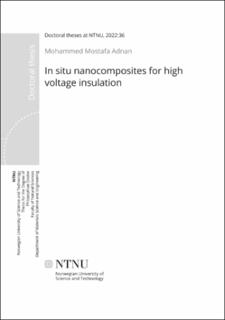| dc.contributor.advisor | Einarsrud, Mari-Ann | |
| dc.contributor.advisor | Glaum, Julia | |
| dc.contributor.advisor | Ese, Marit-Helen Glomm | |
| dc.contributor.author | Adnan, Mohammed Mostafa | |
| dc.date.accessioned | 2022-02-08T09:10:18Z | |
| dc.date.available | 2022-02-08T09:10:18Z | |
| dc.date.issued | 2021 | |
| dc.identifier.isbn | 978-82-326-5861-9 | |
| dc.identifier.issn | 2703-8084 | |
| dc.identifier.uri | https://hdl.handle.net/11250/2977642 | |
| dc.description.abstract | Rapid technological developments and the expanding scope of human activity has significantly increased energy demands. This has resulted in increasing requirements for insulation systems with improved dielectric, mechanical, and thermal properties. Inorganic-organic hybrid nanocomposite materials have attracted attention for use as high voltage insulation materials due to the potential in improving the properties of polymers. Complete realization of that potential requires a deeper understanding of the interfacial interactions between the organic and inorganic components, and of the structure-property relations in these hybrid materials. In this work, three types of inorganic oxide, SiO2, TiO2, and Al2O3, were synthesized directly in the polymer (epoxy) resin using an in-situ aqueous sol-gel route. The effects of variations in the synthesis conditions on the structure and morphology of the nanoparticles and on the properties of the nanocomposites, were studied. Pure epoxy was used as a reference material for the various properties of the nanocomposites that were investigated.
The state of dispersion of the surface-functionalized SiO2 was observed to be significantly improved in nanocomposites were prepared using the in-situ sol-gel route, compared to the nanocomposites prepared ex-situ with pre-synthesized particles. The type and amount of coupling agent used for the functionalization was critical for the dispersion. The in-situ synthesized SiO2 formed diffuse clusters with a hierarchical structure, exhibiting both mass and surface fractals. The structure and dispersion of the SiO2 was observed to impact the glass transition temperature (Tg) and the dielectric relaxations. In general, a high SiO2 content (5 wt%) resulted in a decrease in the real relative permittivity. The resistance of the nanocomposites to electrical tree propagation at 10 kV was also dependent on the state of dispersion of the SiO2. Well-dispersed SiO2 clusters exhibited a ~30% decrease in the growth rate of electrical trees.
The in-situ synthesized TiO2 formed discrete particles with well-defined shapes instead, and no hierarchical structure. Tg for the nanocomposites with TiO2 were generally higher than pure epoxy, and the permittivity decreased with increase filler content. The change in permittivity was different in the epoxy-TiO2 nanocomposites (compared to the epoxy-SiO2), which was attributed to the different morphology of the TiO2 particles. The epoxy-TiO2 nanocomposites also demonstrated an increased resistance to electrical tree propagation at both 10 and 15 kV. The tensile elastic moduli and ultimate tensile strength both increased with increasing TiO2 content.
The Al2O3 structures synthesized in situ were most probably pseudo-Al2O3 resembling amorphous boehmite. These structures formed diffuse clusters similar to the SiO2, but larger in size and with surface fractal features. The epoxy-Al2O3 nanocomposites also demonstrated higher glass transition temperatures and decreasing permittivity with increasing Al2O3 content. The electrical tree initiation was unchanged from that of pure epoxy, and the tree propagation at 10 kV was negligible, demonstrating the best treeing properties among the three types of nanocomposites. At 15 kV however, the tree propagation was comparable to that of pure epoxy.
Overall, the synthesis of inorganic oxide nanoparticles in situ in epoxy resins was demonstrated to be a successful approach in the preparation of nanocomposites for high voltage insulation. The results highlight the importance of the inorganic oxide filler morphology, the filler composition, and the degree of dispersion in determining the properties of the nanocomposites. Structure-property relations were proposed that can explain the changes observed in the properties of the nanocomposites. The in-situ synthesis method used is versatile, and the improved understanding of the structure-property relations can be used to adjust the procedure as required to achieve the desired properties for different applications. | en_US |
| dc.language.iso | eng | en_US |
| dc.publisher | NTNU | en_US |
| dc.relation.ispartofseries | Doctoral theses at NTNU;2022:36 | |
| dc.relation.haspart | Adnan, Mohammed Mostafa; Tveten, Erlend Grytli; Miranti, Rany; Hvidsten, Sverre; Ese, Marit-Helen Glomm; Glaum, Julia; Einarsrud, Mari-Ann. In situ synthesis of epoxy nanocomposites with hierarchical surface-modified SiO2 clusters. Journal of Sol-Gel Science and Technology 2020 ;Volum 95. s. 783-794 https://doi.org/10.1007/s10971-020-05220-3 This article is distributed under the terms of the Creative Commons Attribution 4.0 International License (CC BY 4.0) | en_US |
| dc.relation.haspart | Adnan, Mohammed Mostafa; Nylund, Inger-Emma; Jaworski, Aleksander; Hvidsten, Sverre; Ese, Marit-Helen Glomm; Glaum, Julia; Einarsrud, Mari-Ann. The Structure, Morphology, and Complex Permittivity of Epoxy Nanodielectrics with in Situ Synthesized Surface-Functionalized SiO2. Polymers 2021 ;Volum 13.(9) https://doi.org/10.3390/polym13091469 This is an open access article distributed under the Creative Commons Attribution License (CC BY 4.0) | en_US |
| dc.title | In situ nanocomposites for high voltage insulation | en_US |
| dc.type | Doctoral thesis | en_US |
| dc.subject.nsi | VDP::Technology: 500::Materials science and engineering: 520 | en_US |
